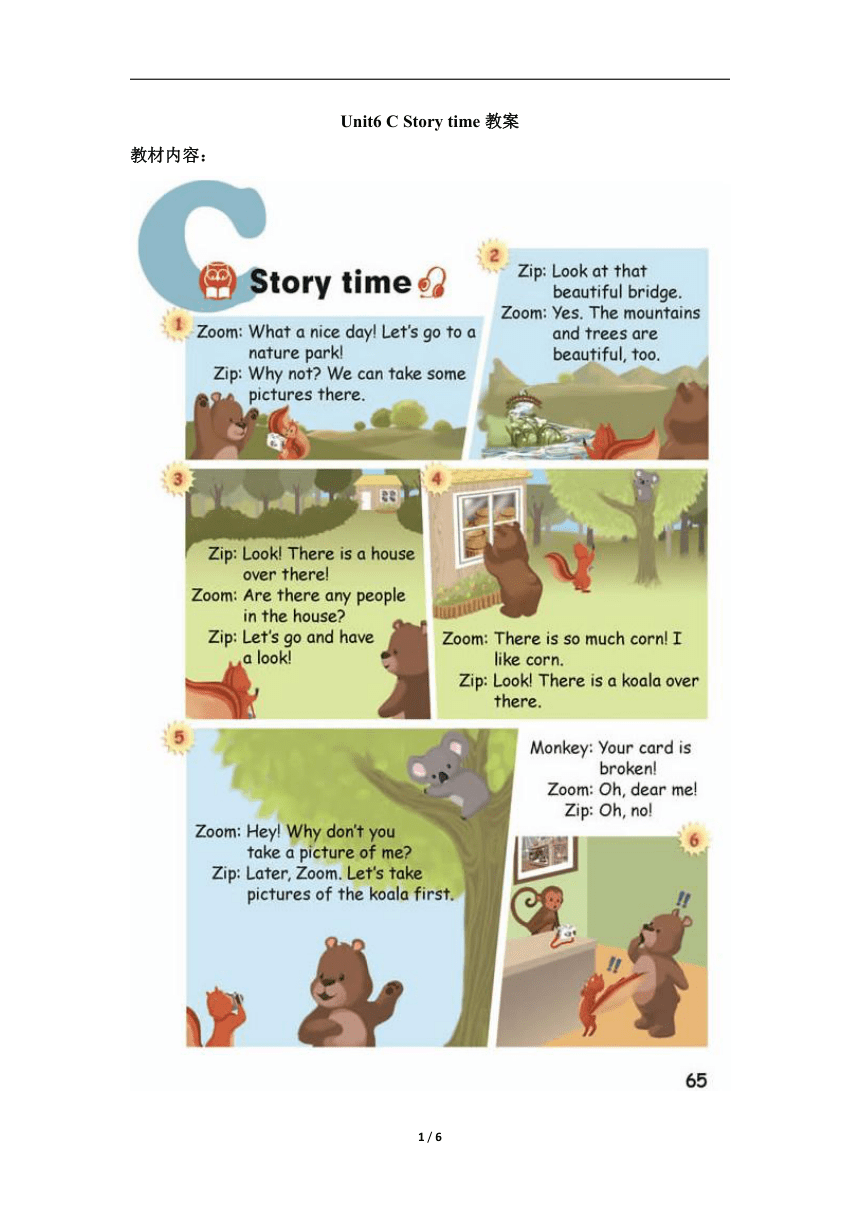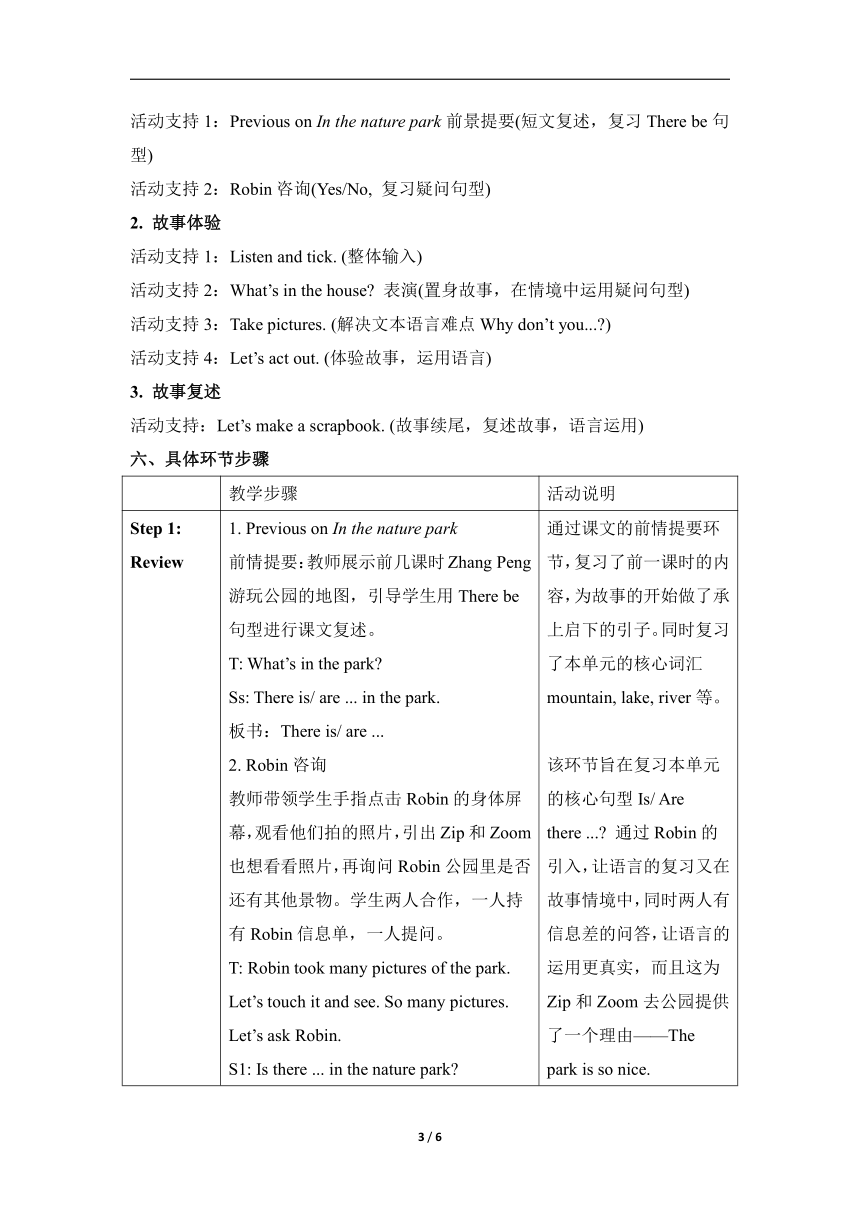Unit 6 In a nature park PC Story time 表格式教案
文档属性
| 名称 | Unit 6 In a nature park PC Story time 表格式教案 |  | |
| 格式 | zip | ||
| 文件大小 | 489.1KB | ||
| 资源类型 | 教案 | ||
| 版本资源 | 人教版(PEP) | ||
| 科目 | 英语 | ||
| 更新时间 | 2019-11-22 17:50:38 | ||
图片预览



文档简介
Unit6 C Story time教案
教材内容:
教 材:人教PEP小学英语五年级上册P65
单元主题:In a nature park
课 型:故事课
一、教材解读
本课内容选自人教PEP五年级上册第六单元C部分。本单元以In a nature park为话题展开教学,通过参观自然公园,学习关于自然公园里面有的景物,激发学生对自然公园的热爱。五年级的学生已经掌握了关于自然事物的单词(如flower, tree等),在第五单元学生已经学习了There be ...的句型表达,能用该句型进行景物的描述。本课时是该单元的第6课时Story time的故事教学内容,在前几个课时,学生已经学习了疑问句型Is/ Are there ...?,能够运用该句型进行事物的是否存在的询问。因此本课时,结合There be ...以及Is/ Are there ...?句型,在完整的故事情境中进行运用。
二、教学目标
1. 知识目标
1) 学生能够正确流利地朗读故事内容。
2) 学生能够在故事的情境中,运用There be ...以及Is/ Are there ...?演绎故事片段。
2. 能力目标
1) 培养学生听、说的能力。
2) 培养学生小组合作、互相倾听、表达的能力。
三、教学重难点
学生能够在故事的情境中,运用核心语言进行故事的演绎。
四、板书设计
C Story time
A visit to a nature park
There is/ are ______.
Is/ Are there ______?
Yes, it is./ Yes, they are. No, it isn’t./ No, they aren’t.
五、设计总体思路
1. 复习
活动支持1:Previous on In the nature park前景提要(短文复述,复习There be句型)
活动支持2:Robin咨询(Yes/No, 复习疑问句型)
2. 故事体验
活动支持1:Listen and tick. (整体输入)
活动支持2:What’s in the house? 表演(置身故事,在情境中运用疑问句型)
活动支持3:Take pictures. (解决文本语言难点Why don’t you...?)
活动支持4:Let’s act out. (体验故事,运用语言)
3. 故事复述
活动支持:Let’s make a scrapbook. (故事续尾,复述故事,语言运用)
六、具体环节步骤
教学步骤
活动说明
Step 1: Review
1. Previous on In the nature park
前情提要:教师展示前几课时Zhang Peng游玩公园的地图,引导学生用There be句型进行课文复述。
T: What’s in the park?
Ss: There is/ are ... in the park.
板书:There is/ are ...
2. Robin咨询
教师带领学生手指点击Robin的身体屏幕,观看他们拍的照片,引出Zip和Zoom也想看看照片,再询问Robin公园里是否还有其他景物。学生两人合作,一人持有Robin信息单,一人提问。
T: Robin took many pictures of the park. Let’s touch it and see. So many pictures. Let’s ask Robin.
S1: Is there ... in the nature park?
S2: Yes, there is.
S1: Are there any ... in the park?
S2: No, there aren’t.
板书:
Is/Are there ...?
Yes, it is/ they are.
No, it isn’t/ they aren’t.
通过课文的前情提要环节,复习了前一课时的内容,为故事的开始做了承上启下的引子。同时复习了本单元的核心词汇mountain, lake, river等。
该环节旨在复习本单元的核心句型Is/ Are there ...? 通过Robin的引入,让语言的复习又在故事情境中,同时两人有信息差的问答,让语言的运用更真实,而且这为Zip和Zoom去公园提供了一个理由——The park is so nice.
Step 2: Tell a story
1. 整体输入
教师引导学生和Zip, Zoom一起去nature park。跟读课文第一段,带读take pictures,并和学生一起做动作。
同桌合作,听录音(故事呈现一半),勾出听到的内容信息。
T: What do you see in the park? What’s in the nature park?
Ss: There is/ are ... in the nature park.
2. 故事递进
学生在图片和课文音频的指引下,跟进课文故事,朗读课文,每到一处,教师带领学生和Zip一起拍照。
学生齐读P2。
学生齐读P3。
猜测What’s in the house?
Ss: Is/Are there ... in the house?
集体起立,跟随老师的指令表演。
T: Wow the house is so big. Let’s jump to see what is in it.
Oh, we still cannot see. Let’s hold the window and stand on your tiptoes. Now tell me what you see.
Ss: There is/are ... in the house.
3. 故事阅读与朗读
课件呈现Koala,学生朗读课文,并做拍照动作。教师总结前面拍的照片,请学生将照片与相应的课文段落连线,再跟着朗读课文。
T: Now please read paragraph 1 to 4 and match the pictures to them.
T: Now let’s read along.
4. 故事再构
通过3张照片都没有Zoom在里面,引出该故事的难点句型Why don’t you take a picture of ...? 并总结Zoom的不满情绪,引导学生有情绪的朗读。再提出Zoom非常爱拍照的人物设定,进行故事再构,操练该难点句型。
T: What else might Zoom take pictures with? Maybe with the mountain ... Please practice by yourself.
S: Why don’t you take a picture of the ... and me? (其他学生集体拍照)
5. 故事演绎
Finally, they’re coming back. 通过课件展示Zoom脑补自己的照片,总结出Zoom 很满意自己的照片,并引出与Zip的对话。学生分角色朗读,再做小组对话活动。
6. 故事尾声
读故事来选一选故事结尾:
A. They print a lot of picture.
B. They don’t have any pictures.
猜测broken的意思。总结:POOR me!
通过听力整体感知故事,并对Robin的list做了二次利用。TPR的活动为课文的理解和故事递进埋下伏笔。
故事递进部分先通过猜测的方式,激发学生对故事的兴趣与期待,再通过浸润式的体验,让学生打开思路,置身在故事中去运用语言,让语言的运用变得有趣、有温度。
故事阅读与配对,加强 、检验学生对故事的理解。
故事再构,为故事的人物增加爱拍照的人设,为语言的练习提供了更为饱满的情境,也为故事开展提供了更为自然的过渡。
通过渲染Zoom很高兴的状态,为故事意外的结局做情绪上的铺垫。小组演绎故事,在完整的故事情节中,运用语言,同时通过语言交互、音量、眼神交流以及肢体语言这4个方面对学生的表演进行引导。
Poor me的总结与之前Zoom脑补自己照片中的画外音Strong me! Cute me! 等形成鲜明对比。
Step 3: Retell
Let’s make a scrapbook.
教师提问
T: What can we do to help Zoom?
Ss: We can ...
引出scrapbook制作手帐的概念。展示手帐的范本,示范制作的顺序。
展示汇报的语言:
In the nature park, there is/ are ...
It’s/ There’re ...
通过提问,帮助Zoom解决问题,来帮助学生养成解决问题的能力,小组活动也培养了学生的合作能力。同时,最后的语言输出又做了进一步的巩固。
Step 4: Homework
1. Read the story.
2. Help Zoom finish the scrapbook and describe it to others.
教材内容:
教 材:人教PEP小学英语五年级上册P65
单元主题:In a nature park
课 型:故事课
一、教材解读
本课内容选自人教PEP五年级上册第六单元C部分。本单元以In a nature park为话题展开教学,通过参观自然公园,学习关于自然公园里面有的景物,激发学生对自然公园的热爱。五年级的学生已经掌握了关于自然事物的单词(如flower, tree等),在第五单元学生已经学习了There be ...的句型表达,能用该句型进行景物的描述。本课时是该单元的第6课时Story time的故事教学内容,在前几个课时,学生已经学习了疑问句型Is/ Are there ...?,能够运用该句型进行事物的是否存在的询问。因此本课时,结合There be ...以及Is/ Are there ...?句型,在完整的故事情境中进行运用。
二、教学目标
1. 知识目标
1) 学生能够正确流利地朗读故事内容。
2) 学生能够在故事的情境中,运用There be ...以及Is/ Are there ...?演绎故事片段。
2. 能力目标
1) 培养学生听、说的能力。
2) 培养学生小组合作、互相倾听、表达的能力。
三、教学重难点
学生能够在故事的情境中,运用核心语言进行故事的演绎。
四、板书设计
C Story time
A visit to a nature park
There is/ are ______.
Is/ Are there ______?
Yes, it is./ Yes, they are. No, it isn’t./ No, they aren’t.
五、设计总体思路
1. 复习
活动支持1:Previous on In the nature park前景提要(短文复述,复习There be句型)
活动支持2:Robin咨询(Yes/No, 复习疑问句型)
2. 故事体验
活动支持1:Listen and tick. (整体输入)
活动支持2:What’s in the house? 表演(置身故事,在情境中运用疑问句型)
活动支持3:Take pictures. (解决文本语言难点Why don’t you...?)
活动支持4:Let’s act out. (体验故事,运用语言)
3. 故事复述
活动支持:Let’s make a scrapbook. (故事续尾,复述故事,语言运用)
六、具体环节步骤
教学步骤
活动说明
Step 1: Review
1. Previous on In the nature park
前情提要:教师展示前几课时Zhang Peng游玩公园的地图,引导学生用There be句型进行课文复述。
T: What’s in the park?
Ss: There is/ are ... in the park.
板书:There is/ are ...
2. Robin咨询
教师带领学生手指点击Robin的身体屏幕,观看他们拍的照片,引出Zip和Zoom也想看看照片,再询问Robin公园里是否还有其他景物。学生两人合作,一人持有Robin信息单,一人提问。
T: Robin took many pictures of the park. Let’s touch it and see. So many pictures. Let’s ask Robin.
S1: Is there ... in the nature park?
S2: Yes, there is.
S1: Are there any ... in the park?
S2: No, there aren’t.
板书:
Is/Are there ...?
Yes, it is/ they are.
No, it isn’t/ they aren’t.
通过课文的前情提要环节,复习了前一课时的内容,为故事的开始做了承上启下的引子。同时复习了本单元的核心词汇mountain, lake, river等。
该环节旨在复习本单元的核心句型Is/ Are there ...? 通过Robin的引入,让语言的复习又在故事情境中,同时两人有信息差的问答,让语言的运用更真实,而且这为Zip和Zoom去公园提供了一个理由——The park is so nice.
Step 2: Tell a story
1. 整体输入
教师引导学生和Zip, Zoom一起去nature park。跟读课文第一段,带读take pictures,并和学生一起做动作。
同桌合作,听录音(故事呈现一半),勾出听到的内容信息。
T: What do you see in the park? What’s in the nature park?
Ss: There is/ are ... in the nature park.
2. 故事递进
学生在图片和课文音频的指引下,跟进课文故事,朗读课文,每到一处,教师带领学生和Zip一起拍照。
学生齐读P2。
学生齐读P3。
猜测What’s in the house?
Ss: Is/Are there ... in the house?
集体起立,跟随老师的指令表演。
T: Wow the house is so big. Let’s jump to see what is in it.
Oh, we still cannot see. Let’s hold the window and stand on your tiptoes. Now tell me what you see.
Ss: There is/are ... in the house.
3. 故事阅读与朗读
课件呈现Koala,学生朗读课文,并做拍照动作。教师总结前面拍的照片,请学生将照片与相应的课文段落连线,再跟着朗读课文。
T: Now please read paragraph 1 to 4 and match the pictures to them.
T: Now let’s read along.
4. 故事再构
通过3张照片都没有Zoom在里面,引出该故事的难点句型Why don’t you take a picture of ...? 并总结Zoom的不满情绪,引导学生有情绪的朗读。再提出Zoom非常爱拍照的人物设定,进行故事再构,操练该难点句型。
T: What else might Zoom take pictures with? Maybe with the mountain ... Please practice by yourself.
S: Why don’t you take a picture of the ... and me? (其他学生集体拍照)
5. 故事演绎
Finally, they’re coming back. 通过课件展示Zoom脑补自己的照片,总结出Zoom 很满意自己的照片,并引出与Zip的对话。学生分角色朗读,再做小组对话活动。
6. 故事尾声
读故事来选一选故事结尾:
A. They print a lot of picture.
B. They don’t have any pictures.
猜测broken的意思。总结:POOR me!
通过听力整体感知故事,并对Robin的list做了二次利用。TPR的活动为课文的理解和故事递进埋下伏笔。
故事递进部分先通过猜测的方式,激发学生对故事的兴趣与期待,再通过浸润式的体验,让学生打开思路,置身在故事中去运用语言,让语言的运用变得有趣、有温度。
故事阅读与配对,加强 、检验学生对故事的理解。
故事再构,为故事的人物增加爱拍照的人设,为语言的练习提供了更为饱满的情境,也为故事开展提供了更为自然的过渡。
通过渲染Zoom很高兴的状态,为故事意外的结局做情绪上的铺垫。小组演绎故事,在完整的故事情节中,运用语言,同时通过语言交互、音量、眼神交流以及肢体语言这4个方面对学生的表演进行引导。
Poor me的总结与之前Zoom脑补自己照片中的画外音Strong me! Cute me! 等形成鲜明对比。
Step 3: Retell
Let’s make a scrapbook.
教师提问
T: What can we do to help Zoom?
Ss: We can ...
引出scrapbook制作手帐的概念。展示手帐的范本,示范制作的顺序。
展示汇报的语言:
In the nature park, there is/ are ...
It’s/ There’re ...
通过提问,帮助Zoom解决问题,来帮助学生养成解决问题的能力,小组活动也培养了学生的合作能力。同时,最后的语言输出又做了进一步的巩固。
Step 4: Homework
1. Read the story.
2. Help Zoom finish the scrapbook and describe it to others.
